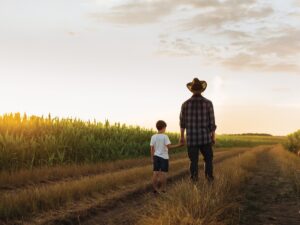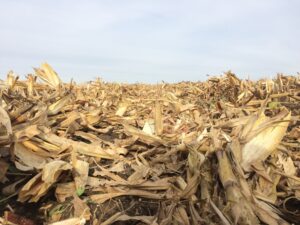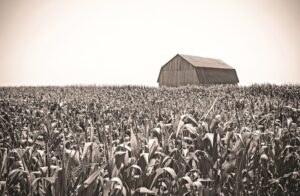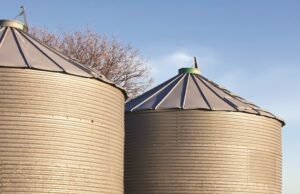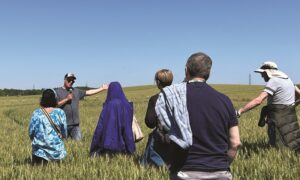Are you ready for corn harvest?
IN 2018, ONTARIO EXPERIENCED A HIGH INCIDENCE OF DEOXYNIVALENOL (DON) IN CORN – COSTING ONTARIO’S GRAIN FARMERS AN ESTIMATED $200 MILLION.

Grain Farmers of Ontario responded by investing in multiple areas of DON research to help mitigate the impact of future DON issues.
One of the key areas of research was genetic screening for DON tolerance. In 2019, the Ontario Corn Committee established trials to refine protocols towards publishing screening hybrids for DON. After five years of refining testing protocols, the Ontario Corn Committee approved the results as relatively accurate and repeatable.
Data from the 2024 Ontario Corn Hybrid Screening Trials will be posted on GoCrops.ca in 2025. Be sure to reference the trials as seed selection is confirmed and again at fungicide timing to help with management decisions for reducing Gibberella ear rot and DON accumulation in corn.
THE BACKGROUND
Corn hybrids were compared against a check hybrid that was highly susceptible to Gibberella ear rot and DON accumulation. The data serves as a relative risk assessment of hybrids and can be used with other sources of information to make informed decisions.
RELIABLE DATA
Highly replicated plots across multiple environments provide reliable data by creating an opportunity for different temperatures at silking, which is known to be a key factor for the conditions that cause Gibberella ear rot. Humidity in the corn canopy is maintained by overhead misting, and ears are inoculated by hand at the best timing for optimal infection. By providing the most favourable conditions for infection and DON development, researchers ensure that the worst-case scenario occurs to ensure that conditions are highly favourable and uniform for disease infection and DON development across all hybrids for reliable hybrid comparisons. The full report of the Ontario Corn Hybrid DON screening trials, as well as yearly hybrid performance data, can be found at www.GoCrops.ca.
Acknowledgements:
Ontario Corn Committee (OCC), Ontario Ministry of Agriculture, Food and Agribusiness (OMAFA), OCC DON sub-committee, seed corn companies (listed below),
Agricultural Research Institute of Ontario (ARIO) for research station infrastructure, Seeds Canada, and in alphabetical order: Dr. Nasim Alijanimamaghani (UG-Ridgetown), Ahmed Alim (UG-Ridgetown), Jonathan Brinkman (UG-Ridgetown), Josh Cowan (Grain Farmers of Ontario), Darrell Galbraith (UG-Ridgetown), Scott Jay (UG-Ridgetown-OMAFRA),
Dr. Katiana Eli (UG-Ridgetown), Michael Heaman (UG-Ridgetown), David Morris (OCC), Todd Phibbs
(UG-Ridgetown), Ben Rosser (OMAFA), Dr. Art Schaafsma (UG-Ridgetown), Carlene Scott (UG-Ridgetown), Cheryl Van Herk (UG-Ridgetown/OMAFA), Ken Van Raay (UG-Ridgetown),
Marty Vermey (Grain Farmers of Ontario), and many summer students.
Sponsors: participating seed companies (2019-2023) Brevant, Corteva Agriscience
NK Brand, Syngenta Seeds Inc.
Country Farm, Country Farm Seeds Ltd. Pioneer, Pioneer Hi-Bred Canada CROPLAN, Winfield United
PRIDE Seeds, AgReliant Genetics Inc. DEKALB, Bayer CropScience Inc.
Saatbau, Saatbau Linz Maizex, Maizex Seeds Inc.
DON 101
WHAT IS DON (DEOXYNIVALENOL)?
DON is a mycotoxin primarily produced by Gibberella ear rot. Infected grain can affect palatability, performance, and can have toxic effects on livestock. As a result of this toxic effect, grain with higher levels of contamination can be rejected or, if accepted, may be discounted at the delivery point.
CONDITIONS FOR GIBBERELLA EAR MOULD INFECTION
Infection occurs with warm (27 °C), humid temperatures, combined with rainfall, that splashes the fungal spores on the silks two to six days after emergence. Cooler, wet weather after silking also favours disease development. Extended periods of rain in the fall promote fungal growth and increase the disease’s severity.
IDENTIFYING GIBBERELLA EAR ROT
Infection begins in the ear tip and moves down toward the ear base, producing a dark red or pink coloured mould. Sometimes, it has a whitish appearance from the mycelium, but it is usually referred to as pink mould. Mycotoxins produced by Gibberella include DON, ZEN and T-2 toxin.
HOW TO PREVENT INFECTION?
- Choose less susceptible hybrids. Reference the current Ontario Corn Hybrid DON Screening Report (found at GoCrops.ca) when selecting hybrids for an indication of the susceptibility for DON infection.
- Spread out the pollination timing of your corn fields to reduce the risk of all fields pollinating during a peak infection period. This can be done by selecting hybrids with different pollination dates or staggering the planting period of different fields.
- Spray a fungicide that suppresses ear mould. Application at fresh silking is recommended. Always read and follow the product label.
- Use of less susceptible hybrids and a labelled fungicide at the right rate and time is the best method. Check with your seed provider for hybrid ratings.
WHAT TO DO IF YOU SEE GIBBERELLA EAR ROT IN YOUR FIELD?
- Call Agricorp to discuss your situation.
- Aim to harvest infected fields as soon as possible. Do not mix old crop or low DON corn with potentially mouldy corn.
- Try to get the cleanest sample out of the combine. We suggest running the combine with the concave setting open and the cylinder speed set low. Set combine to provide high levels of wind to blow out lighter kernels, fines, and cob pieces. Be sure adjustments do not increase kernel damage, as downgrades can result.
- Dry grain quickly, using high- temperature drying to 15 per cent or less. Once the grain is dry, the spread of infection is halted, but the mycotoxins that are already present are not reduced. Cool the grain quickly to less than 10 °C or lower as it will slow the growth of fungi.
- Take a representative sample to the elevator to check grade, quality, and DON levels. If concerns arise, discuss them before you deliver your grain.
- When delivering the grain to the elevator, be sure they are following the proper DON testing procedures (noted below).
- NOTE: DON does not necessarily show up visually in a sample. If there is mould, there might not be DON; if there is DON, there might not be visible ear moulds.
PROPER DON TESTING PROCEDURES
- If you are concerned about how your crop is tested for DON, ask your elevator to grind a two kilogram sample, mix it thoroughly, and then take a sub-sample for DON testing. Research shows that larger samples of ground grain produced more repeatable DON results. For more information, visit the first QR code.
- For more information on accuracy in testing for DON, visit the second QR code.
- Or visit www.gfo.ca/agronomy/crop-management/
- For more information on DON, visit www.cropprotectionnetwork.org and view
- the Ontario Grain Corn Ear Mould and Deoxynivalenol (DON) Mycotoxin Survey, which will be published in October by the Ontario Ministry of Agriculture,
- Food and Agribusiness with additional funding from Grain Farmers of Ontario. This survey gives a good indication of hot spots around the province so that a proactive approach to corn harvest may be taken. For more information on DON research, please refer to the
- Research Project Summaries Database: www.gfo.ca/research/research-project-summaries/. •






